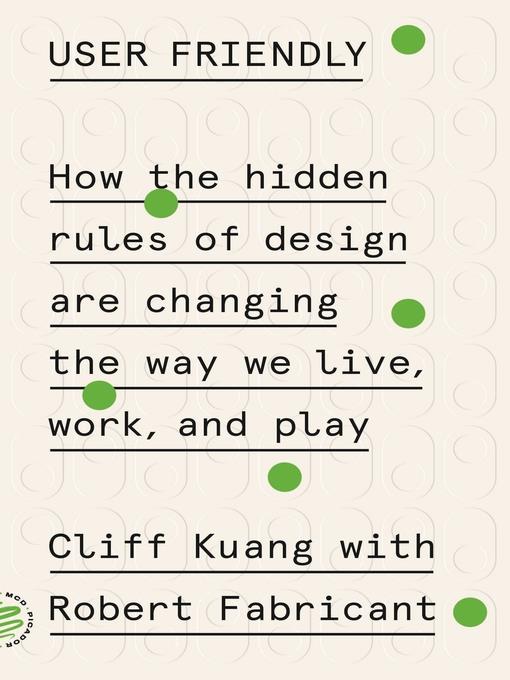
User Friendly
How the Hidden Rules of Design Are Changing the Way We Live, Work, and Play
کتاب های مرتبط
- اطلاعات
- نقد و بررسی
- دیدگاه کاربران
نقد و بررسی

September 23, 2019
Journalist Kuang debuts with this engrossing history of how the design of commercial products and technological innovations came to be singularly focused on the user experience. It proves a sprawling and multifaceted story, with side excursions into near-miss nuclear disasters, WWII fighter plane crashes, and the latest developments in driverless cars. The user-friendly ethos, Kuang explains, requires learning “why people behave as they do” so as to “design around their foibles and limitations.” Not hesitating to get philosophical, he notes that this goal represents a remarkable intellectual shift from “the Enlightenment’s faith in the perfectibility of mankind’s reasoning.” One of the most intriguing chapters considers the use of metaphors in design—for example, the deeply entrenched metaphor of the “desktop” in Apple products—and the value of finding new metaphors. The work also includes profiles of influential designers such as Henry Dreyfuss—who worked on everything from waffle irons and school desks to thermostats and washing machines—and, in an afterword from coauthor Fabricant, cofounder of Dalberg Design, helpful tips for fellow designers on incorporating user-friendly practices. The result is an erudite and insightful exploration of a revolution in human thinking that most people have probably never considered.

October 1, 2019
A readable, instructive study of the role of design in making our lives easier to live. Forget about the perfect mousetrap--how about a better fly swatter? A century ago, an enterprising fellow named Henry Dreyfuss--a hero among many in design editor Kuang and designer/writer Fabricant's lively book--came up with one. "The paddle had concentric rings like a pistol target," write the authors, "which made swatting flies into a game." It was a tossed-off design, but it had a singular virtue: It was self-explanatory "so that the user could readily understand all its functions." Not that a fly swatter has all that many functions, but Dreyfuss' Toperator washing machine did; with easy-to-read controls, it was a revolutionary and fast-selling device. A lesson there is that simplifying things so they become second nature is never a bad idea. Neither is reading the wind and the zeitgeist to figure out where needs lie that may not have been imagined before. That was the case with a different kind of 911 alert that recognized the fact that most attacks on our persons come not from strangers but from people we know--and voilà, a device was born that summoned a concierge to provide "a plausible excuse to dip out of whatever situation you were in, if needed." For the last century, the authors write, the designer's great challenge has been to "reignite the consumer impulse" in a time of general plenty and of constant technological evolution, inventing markets along the way: the iPhone, for instance, or Facebook. (Who knew that coming up with the "like" button required so much work to concoct "the simplest, friendliest way to express positivity"?) Of a piece with the work of Henry Petroski or Donald Norman, Kuang and Fabricant's book serves up plenty of useful examples and offers a few rules for would-be designers, the very first of which is "start with the user." A book that belongs on every designer's shelf--and that consumers of design will enjoy, too.
COPYRIGHT(2019) Kirkus Reviews, ALL RIGHTS RESERVED.

November 1, 2019
User-friendly is a term that many people use, but few think about its meaning. Here, journalist and UX designer Kuang and designer Fabricant dive deep into the definition of the term as it relates to different technologies and their creators. User-friendly is defined here as technologies that "know" what the user wants or needs and are easy for them to master. The authors detail the evolution of technologies as user-friendly despite perils and setbacks throughout history. Biographical information about some of the creators gives insight into how and why technologies were designed, grounding readers in storytelling rather than in technological jargon. By the end of the book, readers will have a better understanding of the ubiquitous term. Those interested in the backgrounds of technologies such as self-driving cars, the Facebook Like button, and even transportation systems will be intrigued to learn about their evolution. VERDICT Kuang and Fabricant offer accessible and thought-provoking insights into the ways that user-friendly design has influenced our lives, along with a contextual history of technology not available in many other books.--Natalie Browning, Longwood Univ. Lib., Farmville, VA
Copyright 2019 Library Journal, LLC Used with permission.

























دیدگاه کاربران